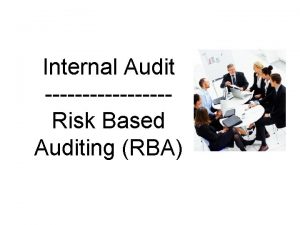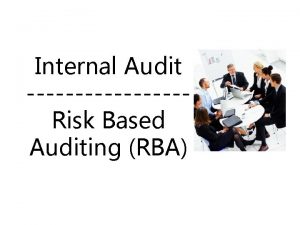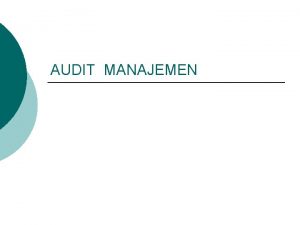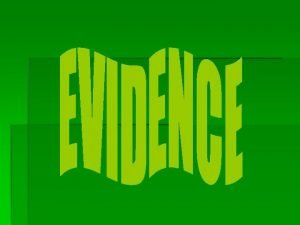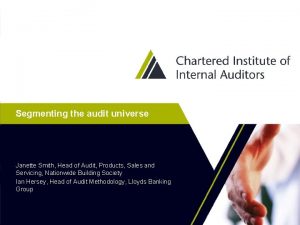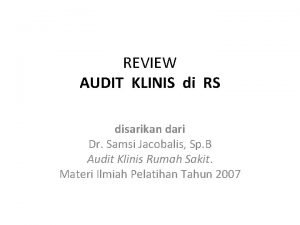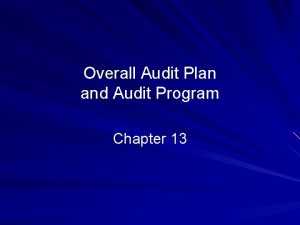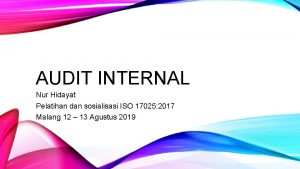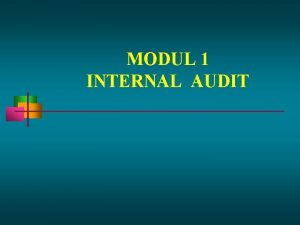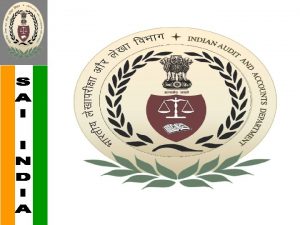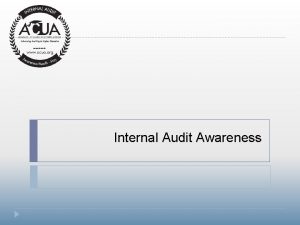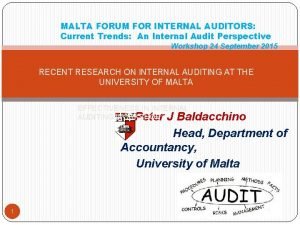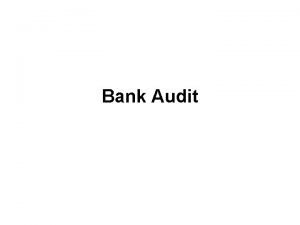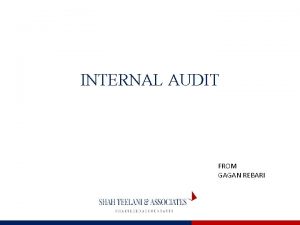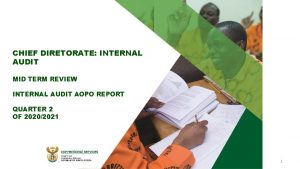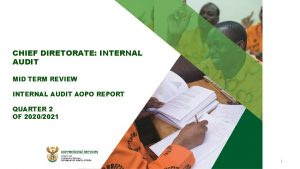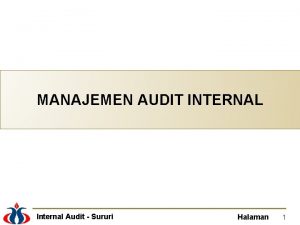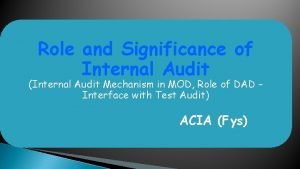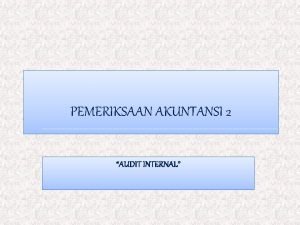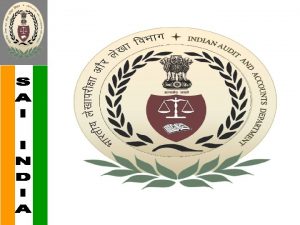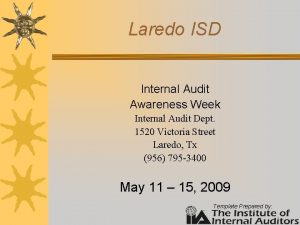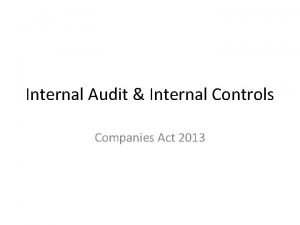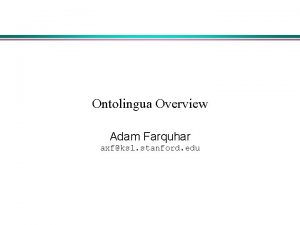An Overview of Internal Audit Jim Farquhar Chief




















- Slides: 20

An Overview of Internal Audit Jim Farquhar – Chief Internal Auditor Deborah Clark – Audit & Risk Manager

What is Internal Audit? • “Internal auditing is an independent, objective assurance and consulting activity designed to add value and improve an organisation’s operations. It helps an organisation accomplish its objectives by bringing a systematic, disciplined approach to evaluate and improve the effectiveness of risk management, control and governance processes”

The Three Lines of Defence Model

Internal Audit Strategy • 2013 -16 Strategy agreed July 2013 • Purpose, Outputs and Performance • Key responsibilities • Links to the risk profile of the Company • Resources

Work Programme • Risk based plan • Internal audit knowledge • Input from directors and managers • Horizon scanning • Approved by Audit Committee

Risk Assessment Tool

Performance • Progress against the plan • Actual hours against planned hours • Number of audit assignments completed against plan • Number of audit recommendations implemented • Audits completed within agreed time • Customer satisfaction levels

Priority of Recommendations • HIGH - These are fundamental weaknesses, which represent a major risk to the organisation, service or establishment and immediate remedial action is imperative • MEDIUM - These are weaknesses, which represent a considerable risk to the organisation, service or establishment and urgent remedial action is necessary • BEST PRACTICE - These issues merit attention and their implementation will enhance the control environment or promote value for money

Priority of Recommendations HIGH • Leads to a failure to achieve organisational or service objectives • Breach of legal requirement • Material error • Major breach of organisation’s policies or procedures • Potential for major public embarrassment

Priority of Recommendations MEDIUM • Significant or frequent error rate • Lesser breach of the organisation’s policies or procedures • Significant potential to improve value for money

Priority of Recommendations BEST PRACTICE • Minor but noteworthy errors • Lesser value for money issue

Reporting Opinions • OPERATING WELL - Used where the system is effective and no recommendations or only a few best practice recommendations have been raised. The vast majority of recommendations from the previous audit need also to have been implemented. • SATISFACTORY - Used where the system works but there a number of medium priority recommendations or where issues have not been addressed from the previous audit. • SIGNIFICANT WEAKNESSES - Used where the system is flawed so there is one or more high priority or a large number of medium priority recommendations. Also where very little or no action has been taken since the previous audit.

The Process • Assignment Brief Issued • Fieldwork Undertaken • Exit Meeting • Working papers and draft report produced • Quality review • Draft report issued • Discussion/Negotiation • Final report issued

Action Plans for Management

Statement of Internal Control Annual review of the effectiveness of the internal control systems covering: • Governance and Risk Management • Performance Management • Financial Management • Internal Audit • External Audit

Special Investigations • Counter fraud and corruption investigations • Financial irregularities • Police liaison

Audit Committee’s Terms of Reference Approval required by the Board following review by the Committee: • To consider draft audited accounts and make • • recommendations to the Board. To (at least annually) report to the Board on the adequacy the Company's financial and internal control arrangements and recommendations for change. To make recommendations to the Board concerning the appointment of the Company's internal and external auditors (subject to ratification at the AGM)

Audit Committee’s Terms of Reference Matters delegated to the committee for decision: • To review the work programmes and performance of the • • • Company's internal and external auditors. To consider the external auditor's management letter and draft a response for the Board to approve. To oversee, the Company's financial and internal control arrangements, including internal audit, risk management, health and safety, delegations and financial regulations. Review and monitor management's response to findings and recommendations of the internal auditor.

Effective Audit Committee • Self-Assess effectiveness against best practice • Ensure you meet the terms of reference • Ask for assurance where you need to • Knowledge of wider organisation and key issues • Horizon scanning • Other assurance providers – The first and second lines of defence

Any Questions?
 Chapter 9 lesson 3 commander in chief and chief diplomat
Chapter 9 lesson 3 commander in chief and chief diplomat Andrew farquhar
Andrew farquhar Perbedaan audit konvensional dengan audit berbasis risiko
Perbedaan audit konvensional dengan audit berbasis risiko Perbedaan audit konvensional dengan audit berbasis risiko
Perbedaan audit konvensional dengan audit berbasis risiko Kerangka kerja audit manajemen
Kerangka kerja audit manajemen The term audit originated from the latin word audit
The term audit originated from the latin word audit Audit informasi klinis
Audit informasi klinis Perbedaan prosedur audit top-down dengan bottom-up
Perbedaan prosedur audit top-down dengan bottom-up Audit universe adalah
Audit universe adalah Beda audit medis dan audit klinis
Beda audit medis dan audit klinis Management audit
Management audit Overall audit plan
Overall audit plan Penyelesaian audit dan tanggung jawab pasca audit
Penyelesaian audit dan tanggung jawab pasca audit Mqa interview
Mqa interview Daftar pertanyaan audit internal iso 17025:2017
Daftar pertanyaan audit internal iso 17025:2017 Evolusi audit internal
Evolusi audit internal Scope of internal audit
Scope of internal audit Kertas kerja audit internal
Kertas kerja audit internal Internal audit data analytics kpmg
Internal audit data analytics kpmg Internal audit awareness presentation
Internal audit awareness presentation Peter j baldacchino
Peter j baldacchino


